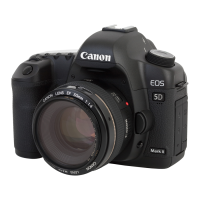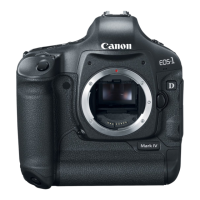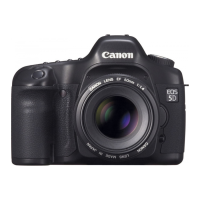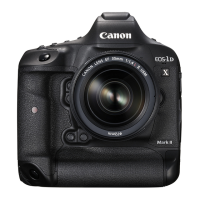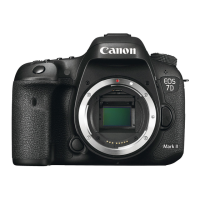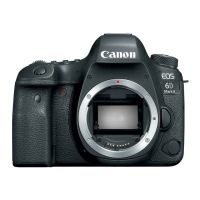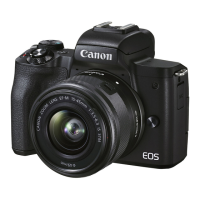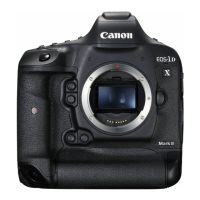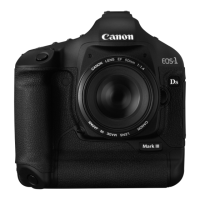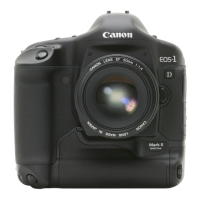Do you have a question about the Canon EOS 5D MARK IV and is the answer not in the manual?
Follow the warnings to prevent death or serious injuries.
Follow the cautions to prevent physical injury or property damage.
Guidelines for proper care and maintenance of the camera to ensure its longevity and performance.
Identification of buttons, dials, and terminals on the camera body.
Explanation of indicators and symbols displayed within the viewfinder.
Explanation of icons and information displayed on the camera's LCD panel.
Instructions on how to charge the camera battery before use.
Procedure for properly inserting and removing the battery from the camera.
Steps for inserting and removing CF and SD memory cards from the camera.
Explanation of the two-step shutter button operation: pressing halfway and pressing completely.
How to set the shooting mode by turning the Mode Dial.
How to use the Main Dial for selecting settings like metering mode and AF operation.
How to use the Quick Control Dial to select settings like white balance and AF point.
Guide to selecting AF operation characteristics to suit shooting conditions or subjects.
How to select AF area selection modes and AF points for effective autofocusing.
How to select cards for recording and playing back images, including settings for two cards.
Guide to selecting pixel count and image quality settings, including RAW and JPEG options.
Instructions on setting ISO speed to suit ambient light levels for optimal exposure.
Explanation of GPS features like geotagging, logging routes, and setting camera time.
Important warnings and restrictions regarding GPS function use in different countries and regions.
Steps to acquire GPS satellite signals and select GPS modes for geotagging.
How to use Program AE mode for automatic shutter speed and aperture settings.
Adjusting exposure to brighten or darken the image for desired brightness.
Automatically bracketing exposure up to ±3 stops for three consecutive shots.
Locking the exposure setting when the focus area differs from the metering area.
Using external EX-series Speedlites for easier flash photography.
Setting Speedlite functions and custom functions via the camera's menu screen.
Steps to enable Live View shooting by setting the Live View shooting/Movie shooting switch.
Customizing the information displayed on the LCD monitor during Live View shooting.
Manually setting shutter speed, aperture, and ISO speed for movie shooting.
Selecting movie recording format, size, frame rate, and compression method.
Requirements for CF and SD cards to ensure proper movie recording.
Solutions for issues related to battery, charger, and camera activation.
Steps to resolve issues with card access or unrecognized cards.
Troubleshooting common problems encountered during shooting.
Troubleshooting steps for unfocused or blurry images.
How to play back captured images on the camera's LCD monitor.
Protecting important images from accidental erasure.
Selecting and erasing unnecessary images individually or in batches.
Processing RAW images to save them as JPEG images with various conditions.
How the camera automatically shakes off dust from the image sensor.
Procedure for manually cleaning the sensor using a blower.
Connecting the camera to a computer to transfer images directly.
Setting print instructions like image selection and quantity for photofinishers.
Adjusting camera functions and button/dial behavior to personal preferences.
Assigning often-used functions to camera buttons or dials.
Customizing the Quick Control screen layout and functions.
Checking battery conditions, remaining capacity, usage history, and registering batteries.
Technical details and specifications of the camera's hardware and features.
Using EOS Utility to transfer images from camera to computer.
Step-by-step guide to installing the EOS software on a computer.
Overview of Wi-Fi functions: smartphone communication, Connect Station, remote operation, printing, FTP transfer, and web services.
Setting a camera nickname for identification and wireless connection.
Basic operations for camera's wireless functions, including settings and touch screen use.
Explanation of NFC function for easy connection to smartphones and Connect Station.
Prerequisites for connecting to smartphones, including app installation and OS versions.
Steps for setting up connections with NFC-enabled and non-NFC-enabled smartphones.
Procedure for connecting the camera to an NFC-enabled smartphone via touch.
Using Camera Connect app to view images, shoot remotely, and change camera settings.
Methods for sending images from camera to smartphone: NFC, wireless connection, Quick Control.
How to connect camera to Connect Station wirelessly to save images.
Important precautions regarding wireless LAN use, country restrictions, and FCC/IC notices.
Follow the warnings to prevent death or serious injuries.
Follow the cautions to prevent physical injury or property damage.
Guidelines for proper care and maintenance of the camera to ensure its longevity and performance.
Identification of buttons, dials, and terminals on the camera body.
Explanation of indicators and symbols displayed within the viewfinder.
Explanation of icons and information displayed on the camera's LCD panel.
Instructions on how to charge the camera battery before use.
Procedure for properly inserting and removing the battery from the camera.
Steps for inserting and removing CF and SD memory cards from the camera.
Explanation of the two-step shutter button operation: pressing halfway and pressing completely.
How to set the shooting mode by turning the Mode Dial.
How to use the Main Dial for selecting settings like metering mode and AF operation.
How to use the Quick Control Dial to select settings like white balance and AF point.
Guide to selecting AF operation characteristics to suit shooting conditions or subjects.
How to select AF area selection modes and AF points for effective autofocusing.
How to select cards for recording and playing back images, including settings for two cards.
Guide to selecting pixel count and image quality settings, including RAW and JPEG options.
Instructions on setting ISO speed to suit ambient light levels for optimal exposure.
Explanation of GPS features like geotagging, logging routes, and setting camera time.
Important warnings and restrictions regarding GPS function use in different countries and regions.
Steps to acquire GPS satellite signals and select GPS modes for geotagging.
How to use Program AE mode for automatic shutter speed and aperture settings.
Adjusting exposure to brighten or darken the image for desired brightness.
Automatically bracketing exposure up to ±3 stops for three consecutive shots.
Locking the exposure setting when the focus area differs from the metering area.
Using external EX-series Speedlites for easier flash photography.
Setting Speedlite functions and custom functions via the camera's menu screen.
Steps to enable Live View shooting by setting the Live View shooting/Movie shooting switch.
Customizing the information displayed on the LCD monitor during Live View shooting.
Manually setting shutter speed, aperture, and ISO speed for movie shooting.
Selecting movie recording format, size, frame rate, and compression method.
Requirements for CF and SD cards to ensure proper movie recording.
Solutions for issues related to battery, charger, and camera activation.
Steps to resolve issues with card access or unrecognized cards.
Troubleshooting common problems encountered during shooting.
Troubleshooting steps for unfocused or blurry images.
How to play back captured images on the camera's LCD monitor.
Protecting important images from accidental erasure.
Selecting and erasing unnecessary images individually or in batches.
Processing RAW images to save them as JPEG images with various conditions.
How the camera automatically shakes off dust from the image sensor.
Procedure for manually cleaning the sensor using a blower.
Connecting the camera to a computer to transfer images directly.
Setting print instructions like image selection and quantity for photofinishers.
Adjusting camera functions and button/dial behavior to personal preferences.
Assigning often-used functions to camera buttons or dials.
Customizing the Quick Control screen layout and functions.
Checking battery conditions, remaining capacity, usage history, and registering batteries.
Technical details and specifications of the camera's hardware and features.
Using EOS Utility to transfer images from camera to computer.
Step-by-step guide to installing the EOS software on a computer.
Overview of Wi-Fi functions: smartphone communication, Connect Station, remote operation, printing, FTP transfer, and web services.
Setting a camera nickname for identification and wireless connection.
Basic operations for camera's wireless functions, including settings and touch screen use.
Explanation of NFC function for easy connection to smartphones and Connect Station.
Prerequisites for connecting to smartphones, including app installation and OS versions.
Steps for setting up connections with NFC-enabled and non-NFC-enabled smartphones.
Procedure for connecting the camera to an NFC-enabled smartphone via touch.
Using Camera Connect app to view images, shoot remotely, and change camera settings.
Methods for sending images from camera to smartphone: NFC, wireless connection, Quick Control.
How to connect camera to Connect Station wirelessly to save images.
Important precautions regarding wireless LAN use, country restrictions, and FCC/IC notices.
| Style | DSLR |
|---|---|
| Color | Black |
| Image Sensor | 36 x 24 mm CMOS |
| Crop Factor | 1.0 |
| Total Pixels | Approx. 31.7 megapixels |
| Approx. 8.29 megapixels (3840 x 2160) | Approx. 20.2 megapixels |
| Image Processor | DIGIC 6+ |
| Lens Mount | EF (excludes EF-S / EF-M lenses) |
| Dual I.S. (6.5-stop Dual I.S. 2 compatible) | Optical 5-axis stabilization |
| Focusing | TTL-secondary image-forming phase-difference detection system with dedicated AF sensor |
| Viewfinder Type | Electronic viewfinder with image sensor |
| Shooting Modes | Sports |
| Picture Styles: Auto | Faithful |
| Continuous Shooting | 21 images in RAW) |
| Exposure Compensation | +/-5 EV in 1/3 or 1/2 stop increments (can be combined with AEB) |
| Automatic Exposure Bracketing (AEB) | 3 |
| ISO Sensitivity | 200 |
| Shutter Speed | 1/8 |
| White Balance | Tungsten light |
| Type | TFT LCD monitor with static touch control |
| Size | 3:2 aspect |
| MP4 H.264 | H.265/HEVC (Audio format: LPCM (2ch 48kHz/16-bit)) |
| MP4 Video: Full HD (16:9) 1920 x 1080 - MPEG4 AVC/H.264 | recording level can be manually adjusted by user) |
| Max Movie Size | 4096x2160 |
| HD - 1280 x 720 (119.9 | 23.976 fps) intra or inter frame |
| 640 x 480 (29.97 | 4K Time-lapse movie |
| MP4: 4096 x 2160: 150Mbps 428 Mins | Max duration 29 min 59 sec |
| Max Image Size | JPEG 3:2: (L) 6000 x 4000 |
| RAW: (RAW) 6240 x 4160 | (S2) 1696x1280 |
| (RAW) 6720x4480 | (1:1) 4000 x 4000 |
| JPEG 1:1: (L) 4000 x 4000 | (S1) 2736x1824 |
| RAW: (RAW) 5472x3648 | (S2) 2400x1600 |
| Wireless Connectivity | NFC |
| Interface Connectors | HDMI connector (Type A) |
| Storage Type | SDHC or SDXC (UHS-I)card |
| 1x SD/SDHC/SDXC and UHS-I | SD |
| Compact Power Adapter CA-CP200L: 24V DC | Rechargeable Li-ion Battery LP-E6N (supplied) / LP-E6 |
| Approx. 860 (at 0°C | FE 50%)20 |
| Approx. -5 to 45°C | - |
| Body Materials | - |
| Water / Dust resistance | Yes |
| Depth | 74.8 mm |
|---|---|
| Height | 110.5 mm |
| Width | 144 mm |
| Net Weight | 800 g |


